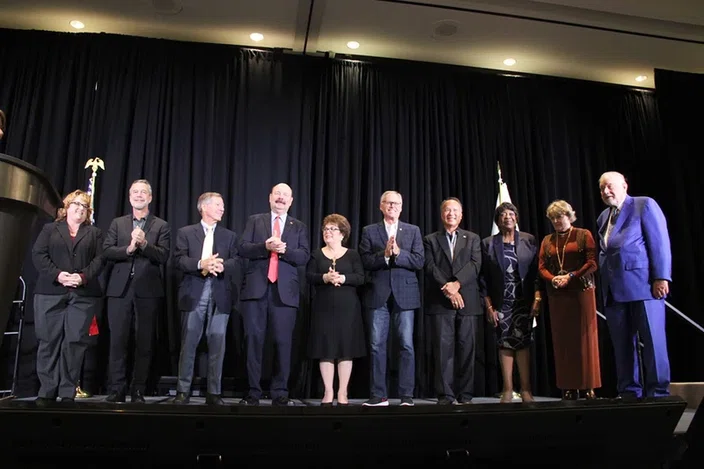Contact Us
www.acsa.org
© 2021 Association of California School Administrators

ACSA’s past presidents who were present at the 2019 Leadership Summit gathered for a photo.
ACSA: A driving force for education
October 4, 2021
The first of three articles looking back at ACSA’s accomplishments over the last 50 years.
Part 1: A Driving Force for Education
Part 2: Developing and Supporting Leaders
Part 3: Advocating for Every Student
It was an ambitious idea at the time: take seven existing school administrator associations in California — each with their own focus area, leadership and staff — and merge them into one.
Then on July 1, 1971, ACSA became the first united school administrator organization in the country.
A trailblazer from the beginning, ACSA hasn’t stopped leading ever since.
Now, 50 years later, ACSA is celebrating five decades of educational leadership while continuing to work toward a better future for each of the state’s more than 6 million students.
“Our 50-year tenure in the business has helped provide ACSA credibility, earned over time, in providing outstanding professional development for school administrators, and in being the leading association advocate for what is best for students,” said current ACSA President Charlie Hoffman (2021-22).
ACSA’s founding
The story of ACSA’s formation is one of innovation, transformation and sacrifice.
Before ACSA, education associations were typically organized around job type or specialty, such as secondary principals or curriculum.
In 1966, the elected officers and executive directors of several different associations began meeting to discuss whether to merge into one new organization or to maintain their individual identities and come together only for specified activities.
According to a publication celebrating ACSA’s 25th anniversary, Sai Herman, a management consultant who volunteered his services to the group, urged that to have a strong administrator voice in California, the existing organizations should be phased out and merged into one new organization.
The advice made sense, and the educational organizations began deliberations for a merger. But then new questions emerged: How would the association be governed? Would there be representation from throughout the state? How many standing committees would there be?
The talks were difficult, and founding members recall plenty of “blood, sweat, and tears.” Co-administrators were afraid that the superintendents, because of their position, would dominate the organization. The superintendents as well as the other merging organizations were afraid that the elementary administrators would dominate because of their larger membership.
By early 1969, proposed bylaws for a new all-inclusive administrator association were developed and a plan of action for presenting the merger proposal to all interested groups commenced. It took several months for the associations to ratify the merger proposal. The merger committee called for a Constitutional Convention to be held in Burlingame on May 22-24, 1970 for the purpose of ratifying the proposal and adopting a Constitution and Bylaws for the new, all-inclusive administrator association.
The “roots” of ACSA’s tree are the following seven organizations:
- California Association of Adult School Administrators (CAASA)
- California Association of County Superintendents (CACS)
- California Association of School Administrators (CASA)
- California Association of Supervision and Curriculum Development (CASCD)
- California Association of School Personnel Administrators (CASPA)
- California Association of Secondary School Administrators (CASSA)
- California Elementary School Administrators Association (CESAA)
“They all gave up their status. They decided that all the separate organizations should unite as one. And that, to me, is extremely praiseworthy,” said former ACSA President Alice Petrossian (2011-12). “They saw everyone as equal partners. That’s what has made us strong, and the fact that we were willing to work on one voice.”
Association’s beginnings
Bill Cunningham, ACSA’s first executive director who served from 1971 to 1980, worked to increase membership (which rose from 8.500 to 13,000 during his tenure).
“People were skeptical when we approached them about membership. They weren’t sure their interests and job types would be fairly represented,” said Cunningham in 1996. “We really worked hard to balance things out and did our darndest to represent all the jobs in every way — from the board to staff appointments to state committees.”
At the start, ACSA’s headquarters were in Burlingame with offices in San Diego, Los Angeles, Irvine and Sacramento.
“It really helped to have inherited staff with experience from the various organizations,” said Cunningham.
Today, ACSA employs a staff of 51 at the state level and 41 in the field with roles and duties that have adapted to the times.
Executive Associate Lori Allred is ACSA’s longest serving current employee, having worked for the association for 35 years.
In 1986, Allred was hired as a receptionist to take phone calls and greet visitors to ACSA’s Sacramento office, which was on L Street at the time. Although typewriters were still predominant, Allred recalls learning how to use the Wang computer and several now-antiquated processes.
“I remember back in the day how we used to mail out the agendas for what was then the Delegate Assembly,” she said, referring to what we now know as the Leadership Assembly. “We would have to color code all the agendas with specific colors for certain parts of the agenda and mail them out.”
Today, Leadership Assembly agendas are e-mailed — and Allred said each time she sends them out, she thinks about how much easier this task has become.
Because of her tenure with the association, Allred has become a go-to resource for members. She has served her entire time in ACSA’s Executive Department and says she never wanted to change jobs.
“One of the reasons why I never wanted to switch out the job that I had working with the board and working with presidents of ACSA is because I organize their ACSA travels visiting all of the regions throughout the year. I enjoy this piece of the job so much,” she said. “You develop such great working relationships with all the presidents that have come along all these years.”
Her relationships with ACSA leaders have given Allred insight into the demands of the role, which requires countless hours volunteered in service to the organization.
“They give their all, even at the region level and charters — the work that’s done at the grassroots. And they have a day job, too,” she said. “Even through this pandemic I’ve seen how hard it’s been. It’s a lot for them. I respect our members wholeheartedly.”
Changes over the years
While the recipe for ACSA worked, there were some modifications over the years.
Following concerns over the lack of equal representation, in 1990 the board make-up was changed from state-elected members to regionally elected members. For the first time in ACSA’s history each region was represented equally on the organization’s governance board.
The faces of ACSA’s leaders have also changed over the years to reflect the diversity of individuals leading schools in California. It took 13 years for ACSA’s first female president, the late Emma Hulett, to take the helm of the organization in 1983-84.
“Much was made of my being the first woman president at the time of my ‘coronation.’ But once in the seat, I was treated as an equal professional,” Hulett wrote in a reflection printed for ACSA’s 25th anniversary in 1996.
By 1992-93, ACSA had its first African-American president, the late Louis Goins, and in 2000-01 its first female African-American president, Lillie Campbell. ACSA’s first Latino president Don Iglesias (2001-02) and first Asian American president Bob Lee (2007-08) followed soon after.
Petrossian remembers running the campaign for Toni Hyland, who she recalled to be the first classified leader to lead ACSA in 2006-07, expanding ACSA leadership to a new job category.
“As long as you’re a member, we’re all equal. I don’t care if you’re an assistant principal or superintendent — if you have the talent, the skills and the desire to serve ACSA, that’s it,” Petrossian said. “If you have paid your dues and you’re a member of ACSA, you should have all rights, equal rights, to all opportunities of ACSA.”
In 2005, ACSA also expanded by adding a new region, Region 19, in order to better represent the growing county of Riverside. Charters have grown over the years as well, with 103 listed in the association’s 1972-73 directory. There are more than 200 today.
Those charters now include retiree chapters for each region. Before retiring in 2000, Dave Davini worked hard to develop the concept of retired member charters, which allow members to continue to give back to ACSA and work on retirement issues that will impact all members someday. Davini is still active in Region 2 and represents State ACSA at CalSTRS board meetings.
“Public education needs ACSA now more than ever,” said Davini, a charter member of ACSA and former Region 2 president. “We fight hard for the best interests of students while representing and protecting the vital interests of professional leaders in all job-alikes.”
Opportunities for leadership
Since its inception, ACSA has provided its members opportunities to lead the statewide association and drive changes in education, whether through service on ACSA’s Executive Board, through its state Councils and Committees, or at the Region and Charter levels.
While being involved in ACSA has expanded its leaders’ impact on students statewide, it’s also made them better leaders at the local level.
“Being involved in leadership opportunities within ACSA has helped me to be better informed, and informed earlier, in the continuous changes happening in California education, which has benefited my school districts many times,” said Hoffman, who is also superintendent of Shasta Trinity ROP/Bella Vista Elementary.
Through seven different governors (including all four terms of Gov. Jerry Brown), through Prop. 13, a couple recessions, and one global pandemic, ACSA has remained a driving force for the equitable education of California students.
“We’ve come a long way as an organization and ACSA has matured and stayed flexible and quickly responsive to the needs of our schools,” said Don Iglesias, ACSA president from 2001-02. “I’m proud to have been an ACSA leader and it is my hope that educational leaders will continue to meet the challenges that confront us and fearlessly step up as leaders in the organization.”
ACSA Leadership Directories from over the decades.








